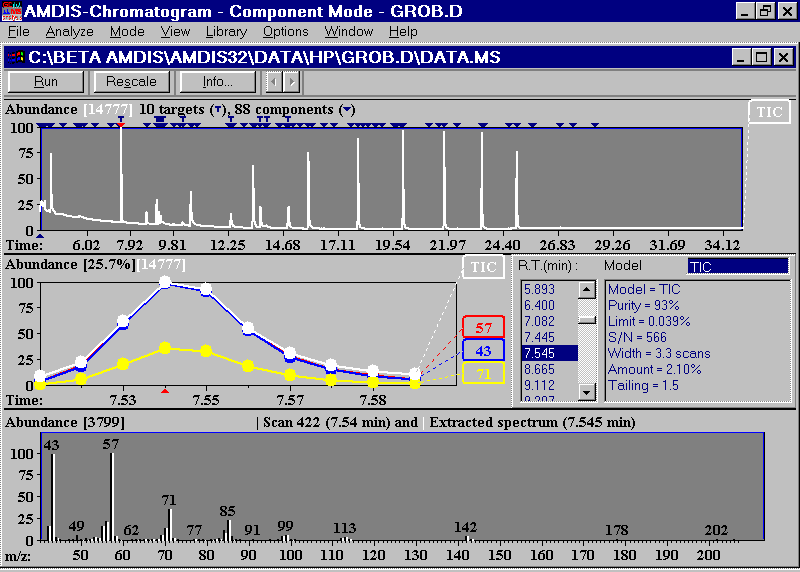User Tools
Sidebar
Table of Contents
Automated Mass Spectral Deconvolution & Identification System
With the support of the Defense Threat Reduction Agency (DoD), AMDIS was developed at NIST for the critical task of verifying a major international treaty, the Chemical Weapons Convention. After more than two years of development as well as very extensive testing, it is now made available to the general analytical chemistry community.
GC/MS Analysis Can Be Done "By Hand"
Gas chromatography/mass spectrometry (GC/MS), has long been the method of choice for identifying volatile compounds in complex mixtures. The most common method for extracting “pure” spectra for a chromatographic component from acquired spectra is to subtract spectra in a selected “background” region of the chromatogram from spectra at the component maximum. However, this method is only appropriate when background signal levels are relatively constant (ionization chamber contamination, for example). Moreover, highly complex chromatograms may have no identifiable “background” region.
How Does AMDIS Differ From Conventional Analysis?
This program extracts the spectrum of each component in a mixture analyzed by GC/MS or liquid chromatography/mass spectrometry (LC/MS) and identifies target compounds. AMDIS is an integrated set of procedures for first extracting pure component spectra and related information from complex chromatograms, then using this information to determine whether the component can be identified as one of the compounds represented in a reference library. The practical goal is to reduce the effort involved in identifying compounds by GC/MS while maintaining the high level of reliability associated with traditional analysis.
The overall process involves four sequential steps.
- noise analysis
- component perception
- spectral “deconvolution”
- compound identification
AMDIS as a "Black Box"
AMDIS can operate as a “black box” chemical identifier by displaying all identification that meets a user-selectable degree of confidence. Identification can be aided by internal standards and retention times. A performance log can be automatically maintained. This “black box” mode shows only the results of an analysis and identification performed by AMDIS.
AMDIS as a Advanced Analysis Tool
AMDIS can also serve as a pre-processing tool for GC/MS or LC/MS data by automatically reconstructing all original component spectra down to the limits of identification for arbitrarily complex matrices. Using AMDIS as a pre-processing tool permits traditional library searching for any selected component. A flexible interface is provided to assist in the analysis of the most challenging matrices.

Libraries
Included with AMDIS from this web page are two libraries, a chemical weapons library and a Grob mixture library. Custom libraries can be built directly from an analyzed data file or from spectra in the NIST/EPA/NIH Database. Additional specialty libraries derived from the NIST/EPA/NIH Database are included with AMDIS in the purchase of the NIST98 Mass Spectral Library. The additional libraries are specific for Flavors and Fragrances, Toxicology, EPA, FDA and Drug analysis.
More Information
AMDIS Manual / User's Guide - a complete description of AMDIS and its functions
AMDIS Method Paper (PDF) - Details of algorithms employed in AMDIS as described in the paper “An Integrated Method for Spectrum Extraction and Compound Identification from GC/MS Data” which appeared in the Journal of the American Society of Mass Spectrometry in Volume 10, 1999, pages 770-781;
